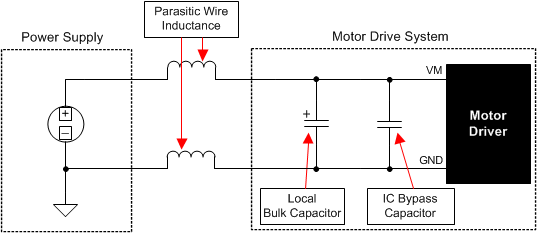SLVSBN4C January 2013 – August 2016 DRV8839
PRODUCTION DATA.
9 Power Supply Recommendations
The input pins can drive within their recommended operating conditions with or without the VCC and VM power supplies present. No leakage current path exists to the supply. There is a weak pulldown resistor (approximately 100 kΩ) to ground on each input pin.
VCC and VM can be applied and removed in any order. When VCC is removed, the device enters a low-power state and draws very little current from VM. If the supply voltage is between 1.8 V and 7 V, VCC and VM can connect together.
The VM voltage supply does not have any undervoltage lockout protection (UVLO), so as long as VCC > 1.8 V, the internal device logic remains active. This means that the VM pin voltage may drop to 0 V, however, the load may not be sufficiently driven at low VM voltages.
9.1 Bulk Capacitance
Having appropriate local bulk capacitance is an important factor in motor drive system design. It is generally beneficial to have more bulk capacitance, while the disadvantages are increased cost and physical size.
The required amount of local capacitance depends on a variety of factors, including:
- The highest current required by the motor system
- The power supply’s capacitance and ability to source current
- The amount of parasitic inductance between the power supply and motor system
- The acceptable voltage ripple
- The type of motor used (brushed DC, brushless DC, stepper)
- The motor braking method
 Figure 12. Bulk Capacitance
Figure 12. Bulk Capacitance